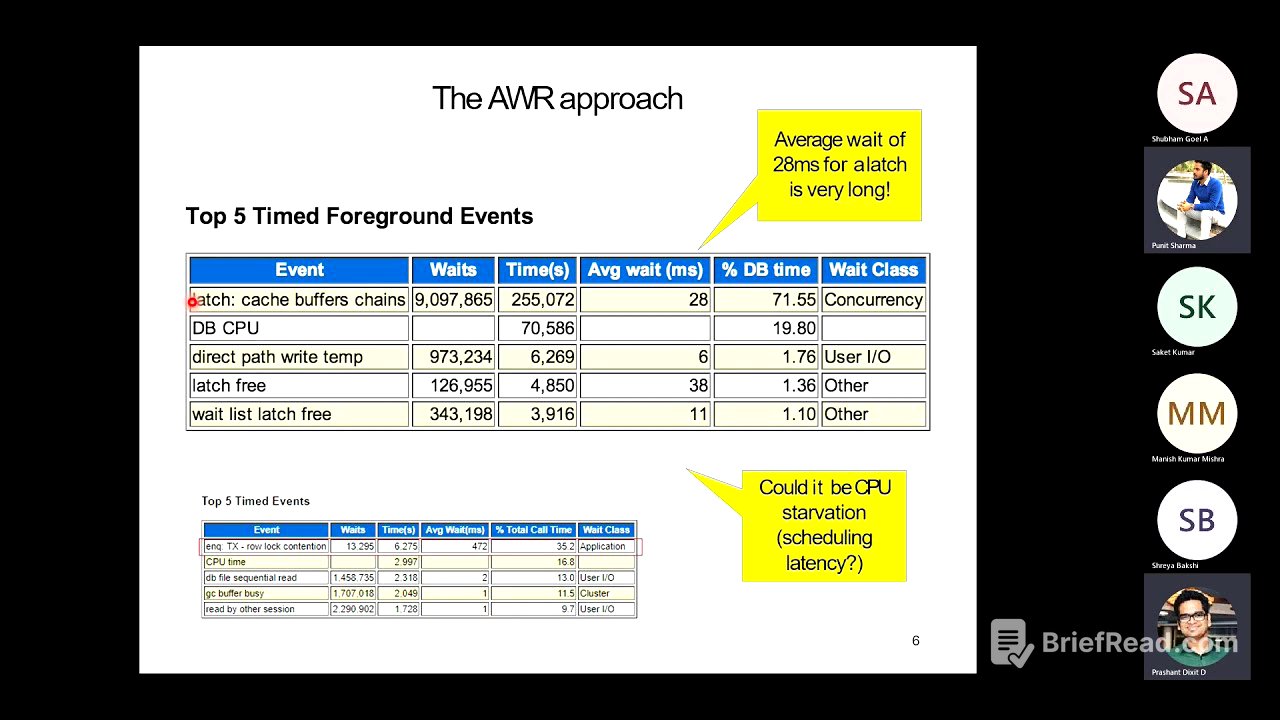TLDR;
This video discusses how to troubleshoot performance issues in an Oracle database using AWR and ASH reports. The video focuses on a specific scenario where the concurrency weight class is high, and the system experiences intermittent slowdowns. The speaker explains how to analyze AWR and ASH reports to identify the root cause of the problem, which in this case is a latch contention on the cache buffer chains. The video also covers the importance of understanding latch behavior, how to interpret different metrics in the reports, and how to use this information to develop a solution.
- AWR and ASH reports are licensed features that provide detailed information about database performance.
- Latch contention on the cache buffer chains can be a significant performance bottleneck.
- Analyzing AWR and ASH reports can help identify the specific SQL statements causing the contention.
Understanding AWR and ASH Reports [0:00]
This chapter introduces AWR and ASH reports, explaining their purpose and how they can be used to troubleshoot database performance issues. The speaker addresses common questions about these reports, such as whether they can be generated without purchasing the Oracle Tuning and Diagnostic Pack, and whether developers can generate them without direct server access. The chapter also highlights the use cases for these reports, emphasizing their value in identifying performance bottlenecks and understanding the overall state of the database.
Analyzing Concurrency Weight Class [3:58]
This chapter focuses on analyzing a specific performance issue related to the concurrency weight class. The speaker describes a scenario where the concurrency weight class is high, leading to intermittent slowdowns. The chapter explains how to use AWR reports to identify the root cause of the problem, which is a latch contention on the cache buffer chains. The speaker emphasizes the importance of understanding the latch behavior and how it impacts database performance.
Understanding Latch Cache Buffer Chains [7:47]
This chapter delves into the details of the latch cache buffer chains weight event. The speaker explains the purpose of the cache buffer chains and how they are used to protect the database buffer cache architecture. The chapter uses a visual representation to illustrate the internal structure of the buffer cache and how latches are used to control access to it. The speaker emphasizes the importance of understanding latch behavior and how even short wait times can significantly impact performance.
Analyzing SQL Statements [27:51]
This chapter focuses on analyzing SQL statements within the AWR report. The speaker explains how to identify the most expensive SQL statements based on elapsed time per execution. The chapter also discusses the importance of considering the total DB time spent by each SQL statement, as it can provide valuable insights into the overall impact of the query. The speaker emphasizes the need to carefully analyze the data and avoid jumping to conclusions about the root cause of the problem.
Analyzing Latch Sleep Breakdown [37:10]
This chapter explains the importance of analyzing the latch sleep breakdown statistics within the AWR report. The speaker describes the different metrics included in this section, such as miss ratio, sleep ratio, and spin gets. The chapter provides a detailed explanation of how these metrics can be used to understand the latch contention behavior and identify potential bottlenecks. The speaker emphasizes the importance of understanding the latch behavior and how it impacts database performance.
Analyzing Latch Miss Source [41:49]
This chapter focuses on analyzing the latch miss source section within the AWR report. The speaker explains how this section provides information about the specific parts of the latch code that are frequently missed by sessions. The chapter also discusses the importance of understanding the different latch functions and how they contribute to the overall latch contention. The speaker emphasizes the importance of understanding the latch behavior and how it impacts database performance.
Using ASH Reports [43:30]
This chapter introduces ASH reports and explains how they can be used to identify the specific SQL statements causing latch contention. The speaker highlights the key advantage of ASH reports, which is their ability to link weight events to specific SQL IDs, providing a clear picture of the relationship between the two. The chapter also discusses the sampling mechanism used by ASH and how it collects data from the database.
Analyzing Top SQL with Top Row Sources [44:28]
This chapter focuses on analyzing the "Top SQL with Top Row Sources" section within the ASH report. The speaker explains how this section identifies the SQL statements that are most frequently waiting on the latch cache buffer chains. The chapter also discusses the importance of considering the percentage of activity contributed by each SQL statement and how it can help prioritize troubleshooting efforts. The speaker emphasizes the importance of understanding the latch behavior and how it impacts database performance.
Understanding P1, P2, and P3 Values [49:48]
This chapter explains the meaning of P1, P2, and P3 values in AWR reports. The speaker clarifies that these values represent different information depending on the specific weight event. The chapter provides examples of how these values are interpreted for different events, such as latch cache buffer chains and db file scattered read. The speaker emphasizes the importance of understanding the specific event and how its P1, P2, and P3 values are interpreted.
Identifying Blocking Sessions [53:08]
This chapter focuses on identifying blocking sessions within the ASH report. The speaker explains how the report can provide information about the session ID and serial number of the blocking session. The chapter also discusses the limitations of ASH reports in identifying blocking sessions, particularly when the blocking session is unknown. The speaker emphasizes the importance of understanding the latch behavior and how it impacts database performance.
Analyzing Sample Weight [55:09]
This chapter explains the importance of analyzing the sample weight section within the ASH report. The speaker describes how this section provides information about the distribution of wait times for the latch cache buffer chains event. The chapter also discusses the importance of considering the wait times that are beyond 10 milliseconds, as they can indicate significant performance bottlenecks. The speaker emphasizes the importance of understanding the latch behavior and how it impacts database performance.
Developing a Solution [56:04]
This chapter concludes the video by emphasizing the importance of developing a solution based on the analysis of AWR and ASH reports. The speaker encourages viewers to use the information gathered from the reports to identify the specific SQL statements causing the latch contention and develop a strategy to address the issue. The chapter also highlights the importance of understanding the latch behavior and how it impacts database performance.




![24 Oras Weekend Express: September 28, 2025 [HD]](https://wm-img.halpindev.com/p-briefread_c-10_b-10/urlb/aHR0cDovL2ltZy55b3V0dWJlLmNvbS92aS94VlAzYXRDeTEzSS9ocWRlZmF1bHQuanBn.jpg)




